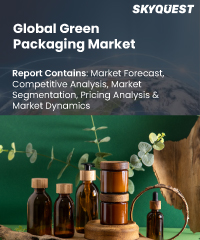
Product ID: SQMIG15H2047

Report ID:
SQMIG15H2047 |
Region:
Global |
Published Date: February, 2024
Pages:
165
|
Tables:
62 |
Figures:
76
Green Packaging Market size was valued at USD 229.46 billion in 2019 and is poised to grow from USD 246.67 billion in 2023 to USD 472.92 billion by 2031, growing at a CAGR of 7.5% in the forecast period (2024-2031).
The sector is expected to grow as a result of severe limitations on the use of single-use plastics and growing consumer awareness of sustainable packaging. The business is expected to expand steadily because of the expanding food and beverage sector, which is using packaging made of recyclable and biodegradable materials more and more. The food service business is switching to goods manufactured from paper or compostable substitutes for single-use plastic straws, lids, closures, caps, cups, and food trays. Because of shifting consumer tastes toward packaged foods and convenience, the foodservice industry will continue to see an increase in product demand.
Due to a growing consumer base that sets a high value on the packaging of consumer products, foods, and beverages, the green packaging market in the US$ is predicted to grow rapidly in the years to come. Manufacturers in the area are adjusting to shifting consumer tastes and shifting to more environmentally friendly options. To advance their environmental initiatives, many major firms in the consumer products industry, including Unilever and Procter & Gamble, have started incorporating post-consumer recycled plastics in their packaging solutions. Hindustan Unilever Limited, a Unilever company, has committed to convert from commodity polymers to performance-based polymers by the year 2028.
Despite the COVID-19 pandemic, the food and beverage sector has grown significantly and is expected to do so over the expected term, which will benefit the green packaging sector. The food and beverage industry continually meets the convenience of the consumer by providing items for on-the-go consumption, which is expected to lead to an increase in demand for packaging in food and beverage applications. The market for packaging used in healthcare has experienced significant obstacles related to sustainable packaging, which grew after COVID-19. This is a result of the numerous limitations that businesses have while producing product packaging.
One of the most important concerns in healthcare packaging is hygiene, and the industry hasn't yet started using recycled raw materials in things like sterile barrier containers. This hesitation is brought on by uncertainty over the packaging product's biocompatibility with the drug or medicine. By working with end-user companies, major players in the sector are reinventing packaging materials and reimagining designs. The coordinated initiatives aim to increase the usage of recyclable and biodegradable materials, as well as their reusability and energy efficiency.
US Green Packaging Market is poised to grow at a sustainable CAGR for the next forecast year.
Our industry expert will work with you to provide you with customized data in a short amount of time.
REQUEST FREE CUSTOMIZATIONGreen Packaging Market size was valued at USD 229.46 billion in 2019 and is poised to grow from USD 246.67 billion in 2023 to USD 472.92 billion by 2031, growing at a CAGR of 7.5% in the forecast period (2024-2031).
Want to customize this report? This report can be personalized according to your needs. Our analysts and industry experts will work directly with you to understand your requirements and provide you with customized data in a short amount of time. We offer $1000 worth of FREE customization at the time of purchase.

Product ID: SQMIG15H2047